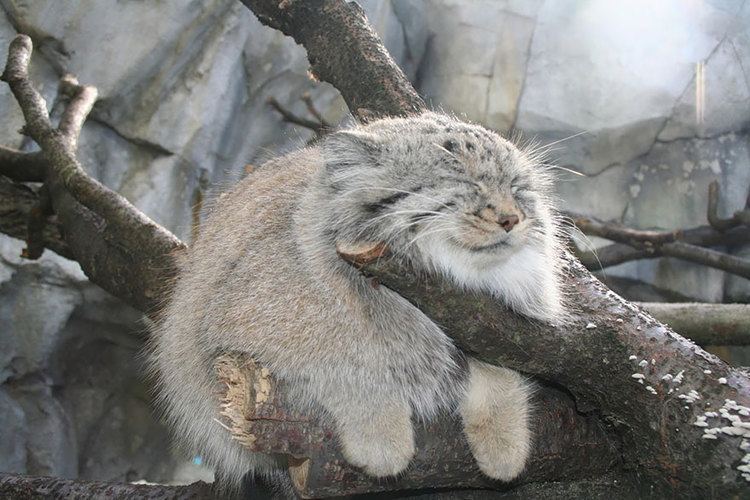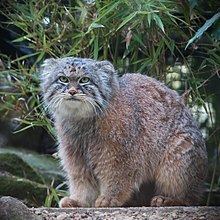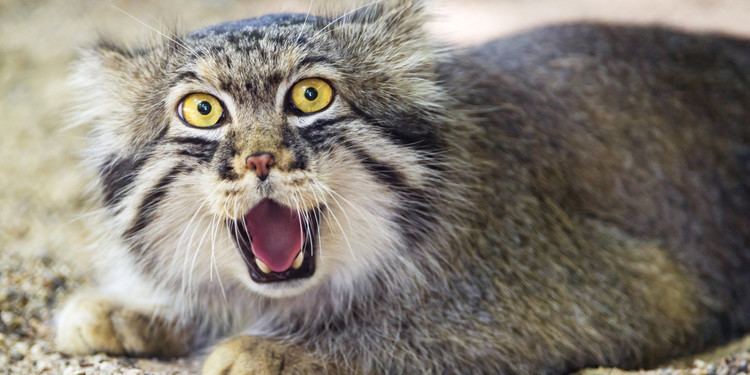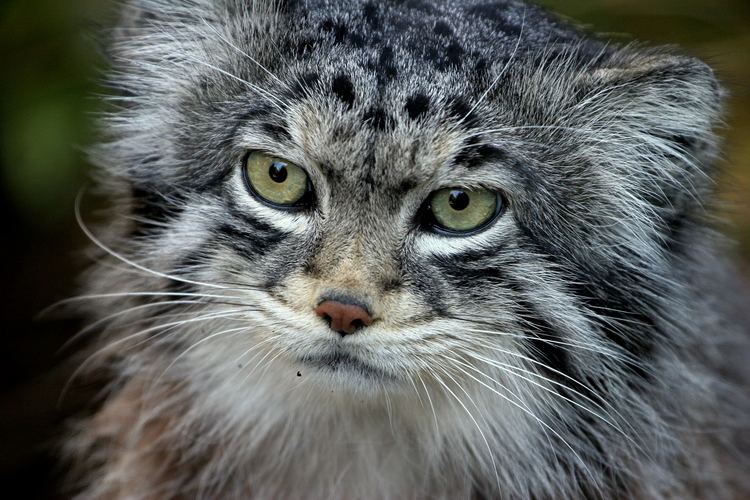Scientific name Otocolobus manul Length 57 cm (Adult) Gestation period 76 days | Phylum Chordata Mass 3 kg (Adult) Trophic level Carnivorous | |
 | ||
Conservation status Near Threatened (Population decreasing) Similar Felidae, Caracal, Serval, Margay, Sand cat | ||
Pallas s cats manul fight
The Pallas's cat (Otocolobus manul), also called the manul, is a small wild cat with a broad but fragmented distribution in the grasslands and montane steppes of Central Asia. It is negatively affected by habitat degradation, prey base decline, and hunting, and has therefore been classified as Near Threatened by IUCN since 2002.
Contents
- Pallas s cats manul fight
- Pallas s cat cubs in mongolia
- Characteristics
- Distribution and habitat
- Distribution of subspecies
- Ecology and behaviour
- Reproduction
- Threats
- Conservation
- In captivity
- Taxonomic history
- References

The Pallas's cat was named after the German naturalist Peter Simon Pallas, who first described the cat in 1776 under the binomial Felis manul.

Pallas s cat cubs in mongolia
Characteristics

The Pallas's cat is about the size of a domestic cat. Its body is 46 to 65 cm (18 to 26 in) long and its tail is 21 to 31 cm (8.3 to 12.2 in) long. It weighs 2.5 to 4.5 kg (5.5 to 9.9 lb). The combination of its stocky posture and long, dense fur makes it appear stout and plush. Its fur is ochre with dark vertical bars on the torso and forelegs. The winter coat is greyer and less patterned than the summer coat. There are clear black rings on the tail and dark spots on the forehead. The cheeks are white with narrow black stripes running from the corners of the eyes. The chin and throat are also white, merging into the greyish, silky fur of the underparts. Concentric white and black rims around the eyes accentuate their rounded shape. The legs are proportionately shorter than those of other cats, the ears are set very low and wide apart, and the claws are unusually short. The face is shortened compared with other cats, giving it a flattened look. The pupils are circular. The short jaw has fewer teeth than is typical among cats, with the first pair of upper premolars missing, but the canine teeth are large.
Distribution and habitat

Pallas's cats are native to the steppe regions of Central Asia, where they inhabit elevations of up to 5,050 m (16,570 ft) in the Tibetan Plateau. They also inhabit some parts of Mongolia, Tajikistan, Kyrgyzstan, India, Kazakhstan, and Pakistan, and occur across much of western China. They also are found in the Transbaikal regions of Russia and, less frequently, in the Altai, Tyva, and Buryatia Republics. In 1997, they were reported for the first time as being present in the eastern Sayan Mountains.
Until the early 1970s, only two Pallas's cats were recorded in the Transcaucasus, both encountered near the Araks River in northwestern Iran; but no records existed from Azerbaijan. Populations in the Caspian Sea region, in Afghanistan and Pakistan, are thought to be declining and becoming increasingly isolated.
In recent years, several Pallas' cats were photographed for the first time during camera trapping surveys:
Distribution of subspecies
Three subspecies are recognized:
Ecology and behaviour
Pallas's cats are solitary. Both males and females scent mark their territory. They spend the day in caves, rock crevices, or marmot burrows, and emerge in the late afternoon to begin hunting. They are not fast runners, and hunt primarily by ambush or stalking, using low vegetation and rocky terrain for cover. They feed largely on diurnally active prey species such as gerbils, pikas, voles and chukar partridges, and sometimes catch young marmots.
Reproduction
The breeding season is relatively short due to the extreme climate in the cat's native range. Oestrus lasts between 26 and 42 hours, which is also shorter than in many other felids. Pallas's cats give birth to a litter of around two to six kittens after a gestation period of 66 to 75 days, typically in April or May. Such large litters may compensate for a high rate of infant mortality in the harsh environment. The young are born in sheltered dens, lined with dried vegetation, feathers, and fur. The kittens weigh around 90 g (3.2 oz) at birth, and have a thick coat of fuzzy fur, which is replaced by the adult coat after around two months. They are able to begin hunting at four months, and reach adult size at six months. Pallas's cats have been reported to live up to 11 years in captivity.
Threats
The manul has long been hunted for its fur in relatively large numbers in China, Mongolia, and Russia, although international trade in manul pelts has largely ceased since the late 1980s. About 1,000 hunters of Pallas's cats are in Mongolia, with a mean estimated harvest of two cats per year. Cats are also shot because they can be mistaken for marmots, which are commonly hunted, and trapped incidentally in leghold traps set for wolves and foxes and snares set for marmots and hares. They are also killed by herding dogs. The fat and organs of the cats are used as medicine in Mongolia and Russia. While Mongolia has not recorded any trophy exports, skin exports have grown since 2000, with 143 reported exported in 2007.
Conservation
Otocolobus manul is listed in CITES Appendix II. Hunting of this felid is prohibited in all range countries except Mongolia, where it has no legal protection despite being classified as Near Threatened in the country. Since 2009, the felid is legally protected in Afghanistan, banning all hunting and trade in its parts within the country and is listed as an endangered species in Pakistan-administered Kashmir.
In captivity
In 2010, there were 47 Pallas's cats in 19 institutions that are members of the Association of Zoos and Aquariums, and four litters were expected. No births and three deaths occurred in 2009. Pallas's cats have the highest percentage of 30-day mortality of any small cat at 44.9%. The seasonality of their reproduction makes it difficult to control reproductive cycles. Keeping Pallas's cats healthy in captivity is difficult. They breed well, but survival rates are low owing to infections, which are attributed to an underdeveloped immune system. In their natural high-altitude habitat, they would normally not be exposed to viruses causing infection.
In June 2010, five kittens were born in the Red River Zoo in Fargo, North Dakota. A female was artificially inseminated for the first time at Cincinnati Zoo, and gave birth to three kittens in June 2011. In May 2013, three kittens were born at the Nordens Ark zoo in Sweden. In May 2016, four kittens were born at the Korkeasaari zoo in Finland.
Taxonomic history
The Pallas's cat initially was placed in the genus Felis. In 1858, the Russian explorer and naturalist Nikolai Severtzov proposed the name Otocolobus for the species. The zoologist Reginald Innes Pocock recognized the taxonomic classification of Otocolobus in 1907, described several skulls in detail, and considered the manul being an aberrant form of Felis.
Following genetic studies, the monotypic genus Otocolobus has been proposed to be placed with the genera Felis and Prionailurus in the tribe Felini, because of a close phylogenetic relationship. Otocolobus manul is estimated to have diverged from a leopard cat ancestor about 5.19 million years ago.
